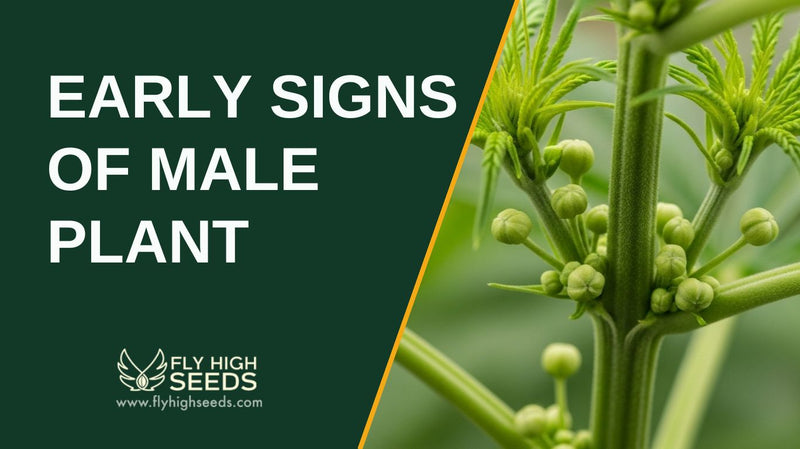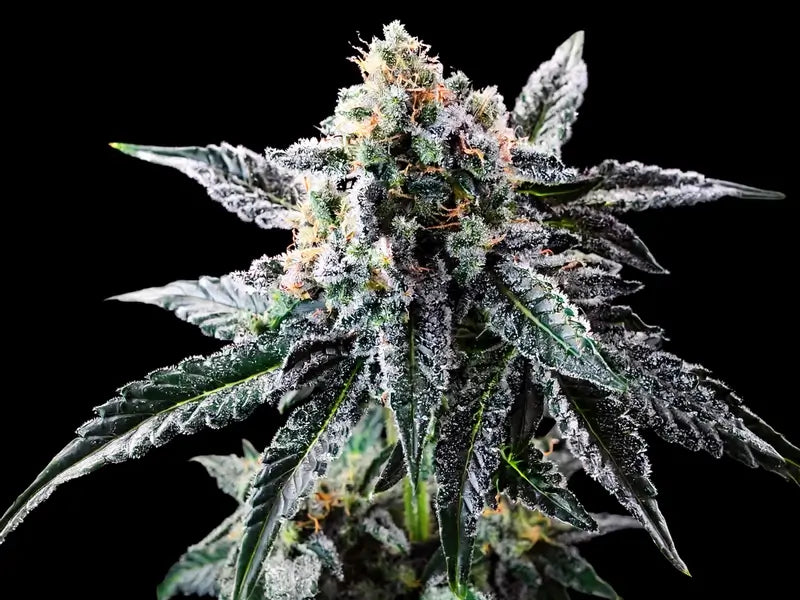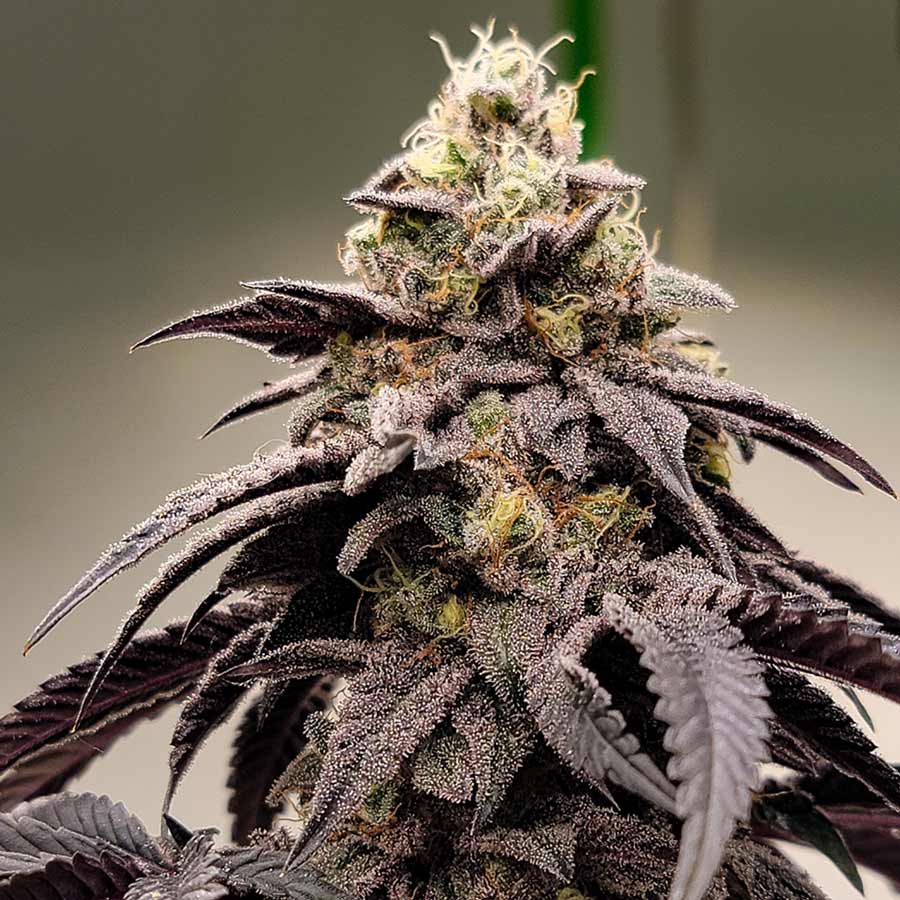Identifying Cannabis Yields: 6 Early Signs of Male Plant

In cannabis cultivation, identifying the sex of your plant early is crucial for a successful harvest. Male cannabis plants can compromise your entire crop if not detected in time, as they produce male pollen that fertilizes female flowers, leading to seed production rather than potent, seedless buds.
Understanding the early signs of a male plant not only helps you preserve the quality of your yields but also ensures that your female marijuana plants can thrive without interference. This guide examines the key traits, timing, and differences between male and female cannabis plants, helping growers determine plant sex early and act accordingly.
Cannabis Plant Sex Overview
Cannabis plants are dioecious, meaning they typically develop as either male or female, though some can become hermaphroditic under stress. Understanding cannabis plant sex is essential for growers who want to maximize yield and potency.
Female cannabis plants are prized for their resin-rich flowers, which contain high concentrations of cannabinoids like THC and CBD. In contrast, male cannabis plants develop pollen sacs instead of flowers and are primarily used for breeding purposes.
When male and female plants grow together, male pollen can fertilize the female flowers, causing them to produce seeds—reducing the quality and potency of the final product. This is why identifying male or female plants early is critical in cannabis cultivation.
Recognizing the plant's sex during the pre-flowering stage allows growers to remove male plants before pollination occurs, ensuring that the crop consists exclusively of female marijuana plants capable of producing dense, seedless buds.
Early Signs of a Male Cannabis Plant
Identifying the early signs of a male cannabis plant is essential to prevent unwanted pollination and preserve high-quality yields. Here are the key indicators to look for during the early growth stages:
1. Thicker Stems and Faster Growth
Male marijuana plants often develop thicker, sturdier stems and tend to grow taller than their female counterparts early on. This robust structure supports the development of pollen sacs later in the flowering stage.
2. Fewer Leaves
Unlike female cannabis plants, male plants usually have fewer fan leaves. This sparse foliage is a subtle but early sign that your plant may be male.
3. Pre-Flowers at the Nodes
In the pre-flowering stage, male cannabis plants begin to show small, round balls (male pre-flowers) at the nodes—where the branches meet the stem. These are early forms of male pollen sacs.
4. Lack of Pistils
Female pre-flowers contain tiny white hairs called pistils. If your plant is not showing these pistils at the nodes but instead has small sacs, it may be a male cannabis plant.
5. Early Development of Pollen Sacs
Male plants often show signs of their sex earlier than females. If you spot grape-like clusters forming early, it’s a clear sign of a male marijuana plant that should be removed before it releases pollen.
6. Absence of Resin Production
Unlike female flowers, male cannabis plants generally do not produce trichomes or resin early on. The absence of sticky, aromatic resin may indicate a male plant.
Regular Vs Feminized Seeds

|
Aspect |
Regular Seeds |
Feminized Seeds |
|
Genetic Outcome |
Produce both male and female cannabis plants |
Bred to produce exclusively female plants |
|
Sex Ratio |
Typically 50% male, 50% female |
Over 99% female |
|
Use in Breeding |
Ideal for breeders; allows selection of both sexes |
Not suitable for breeding (lack of male counterparts) |
|
Pollen Production |
Yes (if male plants develop) |
No (unless hermaphroditic traits appear) |
|
Risk of Pollination |
High if male plants are not identified and removed |
Low risk; only female marijuana plants grow |
|
Yield Potential |
Variable, depends on early identification of male plants |
Higher, as all plants produce female flowers |
|
Need to Identify Sex |
Yes, crucial to determine the sex of cannabis plants early |
No, since plants do not produce male flowers |
|
Cultivation Skill Level |
Better for experienced growers and breeders |
Recommended for beginners or growers focused on cannabis flowers |
|
Stability |
Genetically more diverse; greater variety |
Genetically consistent; uniform growth patterns |
|
Cost |
Generally cheaper |
More expensive due to additional breeding process |
|
Hermaphrodite Risk |
Lower if properly bred |
Slightly higher due to stress-induced hermaphroditic plants |
What to Do with Male Plants
Male cannabis plants can pose a threat to your crop if left unmanaged, but they also have their own uses depending on your goals. Here’s what you can do with male plants once identified:
- Remove Them Immediately: To prevent male pollen from fertilizing female flowers and producing seeds, promptly remove male plants from the grow area as soon as they show early signs.
- Use for Breeding: If you're interested in creating new strains or stabilizing genetics, keep select male marijuana plants for controlled breeding with female counterparts.
- Make Concentrates or Juices: Though low in cannabinoids, male cannabis plants can still be used to make raw juices, teas, or concentrates for mild effects or health benefits.
- Create Mulch or Compost: Chop up male plants and recycle them into compost or mulch to enrich your soil for future cannabis cultivation.
- Collect and Study Pollen: Advanced growers may isolate and collect male pollen for future pollination experiments or selective breeding.
-
Use for Fiber Production: Male plants tend to grow taller and can be repurposed for hemp fiber if you're cultivating industrial cannabis varieties.
Tips for Handling Cannabis Plants
Proper handling of cannabis plants—especially when determining their sex—is essential to protect your crop and maximize flower yields. Here are some focused tips to guide you:
- Inspect Early and Often: Monitor your cannabis plants early in the vegetative stage to identify the sex of your cannabis plants before the flowering stage begins.
- Use Clean Tools: Always use sterilized scissors or gloves when handling or removing male plants to prevent cross-contamination.
- Label Your Plants: Tag each plant to track its sex and development, making it easier to manage male and female cannabis plants separately.
- Isolate Suspect Plants: If you're unsure whether a plant is male or female, move it away from confirmed females to avoid accidental pollination.
- Watch for Hermaphrodites: Keep a close eye on your plants, especially under stress, as hermaphroditic plants can contain both male and female reproductive organs.
- Remove Males Promptly: Once early signs of male cannabis plants are confirmed, remove them quickly to preserve your female marijuana plants.
- Avoid Light Stress: Sudden light changes can trigger stress responses, increasing the risk of hermaphroditic traits. Maintain consistent light cycles.
-
Keep a Grow Journal: Document when your plants begin to show signs of their sex, including the appearance of male pre-flowers or female pistils, to refine your process over time.
Final Thoughts

In cannabis cultivation, early identification and management of male plants play a vital role in ensuring high-quality, seedless yields. By understanding the differences between male and female cannabis plants, recognizing the first signs of male characteristics, and acting swiftly to remove or repurpose male counterparts, growers can protect their female marijuana plants and maximize their harvest. Staying observant, informed, and proactive is the key to successful cannabis plant sex management.
Frequently Asked Questions
Can a female cannabis plant turn into a male?
No, a true female cannabis plant cannot turn into a male. However, under stress, it may develop both male and female reproductive organs, becoming a hermaphroditic plant capable of self-pollination.
How long does it take for cannabis plants to show their sex?
Cannabis plants typically begin to show signs of their sex between 4 to 6 weeks of growth, during the pre-flowering stage. The exact timing can vary based on strain and growing conditions.
Do male cannabis plants contain THC?
Yes, male cannabis plants do contain THC, but in significantly lower concentrations than female plants. They are not suitable for harvesting potent cannabis flowers.
Can you grow only female cannabis plants from regular seeds?
Not reliably. Regular seeds have roughly a 50/50 chance of being male or female. To grow exclusively female plants, you need feminized seeds or must sex the plants early and remove the males.
Is it possible to reverse a male cannabis plant into a female?
No, a genetically male cannabis plant cannot be reversed into a female. Only female plants can be manipulated (e.g., through colloidal silver treatment) to produce male pollen for feminized breeding.



